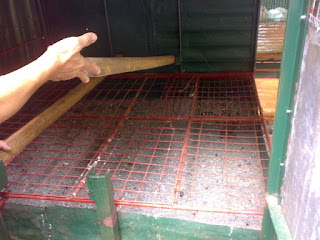Who is that tall rooster inside the chicken run? Well, that tall and handsome rooster happens to be my DH Brad.
My DH likes cutting up the vegetables before giving it to the chickens. He feeds them with vegetables from our garden.
Brad going inside the chicken run with more greens for the chickens. The chickens go crazy whenever they see him coming.
Oops sorry! I could not find the key so you'll have to stay locked up with the chickens in the run for the day!
Providing some roosting bars in the run gives more space to the chickens. We made a crude ladder for them as they were still too young to fly up to the roosting bars and they used this ladder a lot. We also provided several roosting bars in the chicken run from the left over trunk of the trees that we cut around the property and they use all of them. They would jump from one roost bar to the other and try to catch anything that is flying around in the run. The runt among the group always manages to find the smallest space to squeeze itself out.
We put a potted plant inside the run and they demolished the leaves in no time. So my DH provides them with some grass or vegetables from our garden and feeds it to them. Since the chickens are still young, he cuts up the greens so they could eat these better. We started giving them greens at a very early stage as soon as they started eating their mother's food which is why they are so used to having greens now.




















